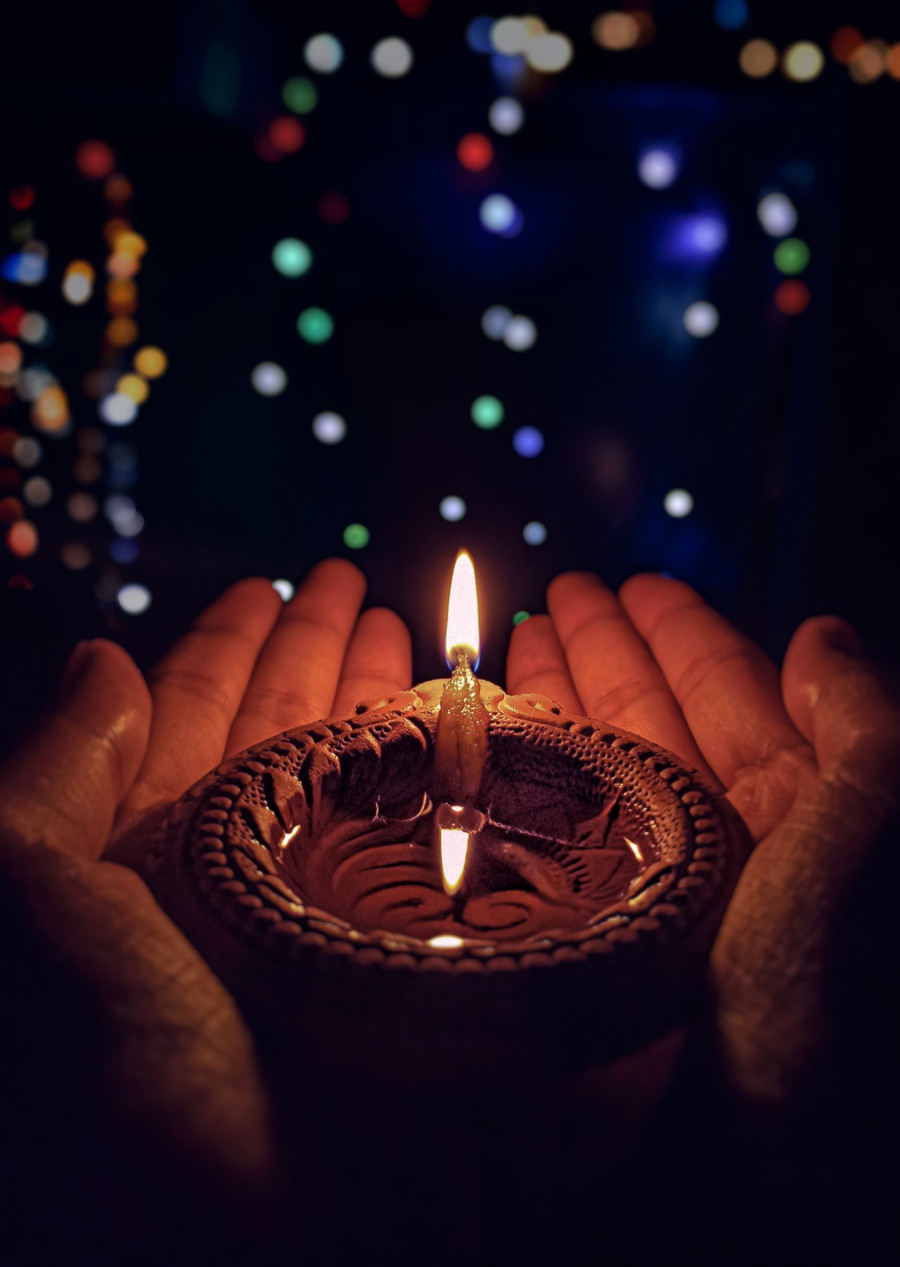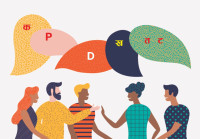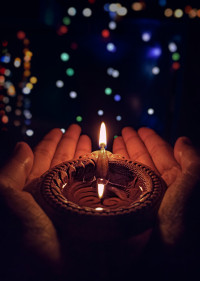As it is
A Buddhist family celebrating Tihar--a Hindu festival
The desperate need for preserving one’s own culture catches people off guard when they witness an ‘outsider’ not only acknowledging their traditions but somewhat even adopting them.
Pasang Dorjee
Rangolis, diyos, vibrant lights, and all the array of festive paraphernalia that accompany the week of Tihar ring in my brain as I try to trace just how far back my affinity for this festival goes; but that would be akin to jogging up the most distant memories I can't even recall precisely. Tihar, nonetheless, instilled a default holiday mood for our Buddhist family, as it did for the majority in Nepal. Of course, we have our Gyalpo Lhosar, which has its own set of religious protocols we would adhere to; the charm of `Tihar, however, is unlike anything else.
Perhaps, when I was a young boy, those month-long breaks from school translated into a fondness so deep for a culture foreign to my own; this liking, nonetheless, transcended just the need for a time off from school. I, like every other kid, would be enthralled by the sheer vibrancy of Kathmandu during this period. I am well aware that the ubiquity and pervasiveness of this culture would not be relevant to several ethnic minorities in Nepal, since it has its fair share of history, mainly that of a culturally hegemonic one—I am merely carving out my own account, and that of my family’s relationship with Tihar.
Whenever I share with my non-Sherpa friends and acquaintances that we as Sherpas, and a Buddhist family, have been celebrating Tihar for as long as I can even remember, I am typically met with astonishment and baffled looks, along with delighted remarks. We are certainly not familiar with intricate details of the rituals followed during Tihar; our family still relish in the other lighter aspects of the festival. I wouldn’t wish to universalise this experience, because this could be unique to my family alone, and maybe a few others; however, my family’s relationship with Tihar is replete with memories of dancing and singing performances, competing with neighbours on rangoli decorations, and adorning the house with colours, marigolds, and diyos.
Hindu deities bearing similar versions and interpretations in Buddhism also allowed our family to be more open to and accepting of a Hindu festival. For instance, Lakshmi Puja, one of the most important rituals during Tihar, is performed to invite the Goddess Lakshmi at home. As Lakhshmi is the Goddess of Wealth and Purity, we would worship the deity Dzambala—the God of Wealth in Tibetan Buddhism—during Tihar. Even though my family still occasionally puts up a photo of Goddess Lakshmi at the altar, the essence of Tihar remains, regardless of which deity we worship. On other occasions, such as Saraswati Puja, I remember being incessantly coaxed by my mother into visiting any Saraswati temple; it was she who laid the foundation for me and my brother to feel increasingly comfortable and, more importantly, normal to frequent Hindu temples.
Tihar has established itself as the go-to celebration, not because of the myriad of pujas and ceremonies that follow, but because it is a festival that transcends cultural and ethnic identities. Oftentimes, multiple generations of the same family are involved in the festivities, and singing deusi-bhailo typically becomes a common ground for people of different religious and ethnic backgrounds to toss their differences aside. This is primarily because children are the ones spearheading such celebrations. The concept of deusi-bhailo for a kid entails hopping from one house to the next, collecting money and sweets—so one’s religious background or ethnicity is an irrelevant subject, especially since Tihar for many children simply is an opportunity to earn some pocket money.
I believe that as children, the concept of ethnicity, race, class, etc., are yet to be engineered into them. It is because children are either ignorant or apathetic towards these concepts and are thus unrestrained in their spirit for celebration regardless of whom the festival belongs to. Children may not know the differences in various cultures and ethnicities, but that should only inspire adults to acknowledge how the identities they inherit and are often rigid about, establish barriers where there were none before. You can certainly acknowledge the differences whilst venerating your own cultural history, but also realise some of the negative repercussions that spring out of being unable to look past those differences. It is perhaps out of the children’s ‘naivete’ that we can derive fundamental lessons on becoming more critical of our societal conditioning. And perhaps nourishing one’s own ‘inner child’ lies in realising who we once were before the world got its hands on us.
Tihar was—and still is—a period that allowed us to build rapport with our neighbours, whom the festivals actually belonged to. Bombarded with sel-roti and sweets from one household to the next, we never felt as though our heritage was being encroached upon, infiltrated by unfamiliar practices; it was just Tihar, plain and simple. The desperate need for preserving one’s own culture catches people off guard when they witness an ‘outsider’ not only acknowledging their traditions but somewhat even adopting them.
It would be easy for someone to construe this as ‘losing touch’ with our own roots, or that we didn’t hold our own traditions in higher regard; the simple answer was that we didn’t make anything out of celebrating Tihar; no deeper implications other than the simple longing for celebration. This anxiety around ‘losing your culture’ is something many of us Nepalis are well acquainted with. This narrative has filtered down to the contemporary social scene as well, especially when Nepalis deride other Nepalis for celebrating predominantly western festivals like Halloween or Christmas—often disregarding the fact that there is a Christian population in Nepal, too. Passing gratuitous remarks towards people because you feel threatened and insecure about ‘losing your culture’ is, I feel, myopic and unnecessary. You can put on Halloween costumes, buy presents for Christmas, party during the English New Year and still hold a place deep in your heart for your own customs and traditions. This black and white thinking enables people to deem anything they are unfamiliar with as ‘bizarre’ and sometimes even hostile. Sentiments like these gradually foster xenophobia, as the ‘otherisation’ and polarised perception becomes heightened in them, and those differences become a tool to initiate vitriol and bigotry.
Religious tolerance has been the hallmark of Nepali identity for decades; it is an integral aspect of how we have been defining ourselves as a community in the global context, too. Harbouring ill intentions over differences in identities because we feel that our own ‘tribe’ needs to triumph in some way, is undoubtedly rooted in ignorance and a fragile sense of self. Having a healthy feeling of pride in one’s culture and heritage should be encouraged, however, if that becomes the only thing you can outsource your entire identity from, it inevitably leads to defensiveness and groundless insecurity over labels we inherited by the mere virtue of coming into existence.
My parents embedded in me the kind of cultural tolerance that I can perpetuate through the stories I share with people I cross paths with—and for that, I am eternally grateful. Not only has this made me realise the adverse impact of being radically fixated on labels and identities, I can sense how it has also pervaded other areas of my life. Whether it's accepting differing opinions, ideologies, or even in dealing with personalities that are the polar opposite of my own, in an objective and sensible manner.
Preaching ‘love’ and ‘acceptance’ is one thing, and actually internalising and implementing is another ballgame of its own. And it's in minute steps like a Buddhist lighting a diyo, or putting on Tika, or perhaps a Hindu visiting Buddhist monasteries and lighting butter lamps—even when it’s supposed to be culturally or religiously irrelevant to them—that we gradually learn to embody acceptance, celebrate differences and empower each other’s cultures.




 16.54°C Kathmandu
16.54°C Kathmandu








.jpg&w=300&height=200)

